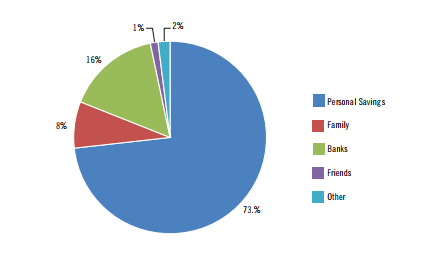What Is My Innovation Worth?
Many times, over the last 10 years I have been asked by excited innovators how much their idea, innovation, or invention is worth. Everyone would love to hear that their idea is worth millions or even billions but the truth is, all of the mainstream valuation methods incorrectly assume that your innovation will successfully enter the marketplace.
A better question would be to ask what your potential idea/start-up’s Innovation Readiness Level (IRL) is. Knowing your IRL will help you figure out how to add value to your innovation and better prepare you for a successful market entry.

What is Innovation Readiness Level?
Innovation Readiness Level describes the stage of business development for product, service, technology, or social innovations. Diligently working through each level in the IRL chart may bring you one step closer to taking your idea from concept to market fruition.
You can also use the IRL chart as a roadmap of how your innovation’s value increases as you get closer to successfully launching it into the marketplace. Clearly, the more thought, planning and development that you have put into your innovation, the greater the potential value to investors, licensees, or buyers.
The concept of IRL is similar to the Technology Readiness Level (TRL) developed by NASA in the late 1980’s for technology innovations. Although TRL analysis has pretty much become the standard of how funding for technology is based; it does not adequately take into account how prepared for actual commercialization innovators and their teams need to be. A good IRL analysis fill this gap.
The success rate of high-tech start-ups is no better than any other category. The number one reason start-up companies fail is because they run out of money. The early focus of IRL on thinking through an idea and business planning helps entrepreneurs make wiser use of money and resources. This is especially valuable for the vast majority of new businesses and innovations that originate as simple improvements for products and services.
The Spectral Torch

If you want to see or present your innovation in the best light, entrepreneurs should be able to demonstrate that they have thought their idea through from concept to their end-goal. The IRL chart can assist entrepreneurs in making sure they have not missed the essential building blocks for a successful innovation launch..
Understanding Innovation Readiness Level groupings
The groupings within an IRL are directly related to the amount of time and effort put into your idea. This is not to say that every innovation must follow the same steps in the same order because there will always be exceptions. However, it does reinforce the fact that starting a business or developing an innovation is hard work and innovators must be willing to make the effort.
The IRL groupings look at the effort mentioned above and asks the following questions:
-
- What problem does it solve? (if it doesn’t solve a problem your idea is probably worthless). Having an idea regardless of how creative or disruptive it has the potential to be, does not have much value (if any) until you can demonstrate that value.
- What is the business concept?
- That you have thought through your idea? Including but not limited to: Research, competitive products/services, uniqueness, costs/benefits
- That you have a plan through your end goal. For example; Will you be implementing the idea yourself, licensing to others or selling it?
- Do you have a prototype or working model that you can show others?
- Do you have systems designed to support the production or implementation of your idea?
- Budget
- IT
- Financial Controls
- Business Plan
- Web Presence
- Cash Flow
- Have your systems been put to the test in a real-world environment yet?
- Are you ready for full scale production or implementation?
- Staffing
- Capital
- Sales
- Marketing
- Operations
Innovation Readiness Level Descriptions
Below is how the answers to the preceding questions are grouped together. You should be able to identify the stage of development that your innovation is at and make plans accordingly.
Innovation Readiness Level 1 – 2
IRL of 1 indicates that you only have an undeveloped idea. Realistically, if the IRL for your innovation is 1, no one in their right mind is going to invest a penny with you. There are a million ideas at this level of development and they are not worth squat until you think your idea through.
On the other hand, an IRL of 2 indicates you know what problem your innovation solves or can define a specific opportunity and have a business concept in mind. Properly defining the problem is a cornerstone of innovation.

Innovation Readiness Level 3 – 5
An IRL of 3 through 5 suggests that you are focused and will provide potential investors/buyers/licensees with something tangible they can see and get excited about. This is the level that is most likely to attract incubator type seed money (enough to get you going for further development).
In this grouping you are building value and moving forward by completing your business plan, building a scaled down prototype and/or designing the systems needed to support your product/service. The biggest challenge in this group is making sure you know exactly how your innovation will work and what it will take to get it to market.
“Creating value is a collaborative process, if you always have to be the smartest person in the room your innovation is destined to fail”
Things to have considered and completed during these IRL stages include:
-
- A dynamic business plan that shows at a minimum:
- You have adequately defined the need your innovation addresses.
- Competitive research: Evidence of competitive research on similar products/services, the state of current research in the field, possible patents, etc.
- Your innovations potential and uniqueness: Why should people invest or purchase your innovation and can your innovation be easily reverse engineered?
- Resources needed (capital, equipment, people etc.).
- Who is on your team.
- Sales and Marketing: A detailed explanation of how sales will be achieved and the cost of sales.
- Design and Development Costs.
- Ongoing operational costs and burn rate until profitability.
- A list of all support systems that will need to be in place (financial, operational, IT, web, legal, HR
- Critical Risks, Problems and Assumptions: You know and have weighed the known costs and benefits against each other and can explain why you should go forward by the numbers.
- That you know your Intellectual Property IP needs. For example, do you need a Patent or Trademark and at what point should you seek IP protection?
- A dynamic business plan that shows at a minimum:
- Prepared flexible, actionable plans: 30,60,90 days or longer plans on how you will get your innovation to IRL 6 and above.
- A working small-scale prototype or a demonstrable model of the innovation. This applies to service, manufacturing, software, web-based and product innovations. The million-dollar question has always been, will it work? Prove it and the value of your innovation jumps up significantly.
- Who will be your true mentor. Working on a new venture can be a very emotional roller coaster. A mentor can help even the ride out.
Does the above sound like a lot? It should because failure to think through your idea is the number one reason entrepreneurs run out of money. Good financial management in the early stages of innovation development comes from a superior knowledge of your current and projected expenses. Always remember that Cash is King.
Innovation Readiness Level 6 – 7
The next grouping is an IRL of 6 or 7. At this stage you are putting together the final pieces of your new venture. The most critical components at this stage are:
- Completing your business and action plans. Note: A good business plan is a living document that you can adjust as new information becomes available. It is extremely rare that everything will go according to plan.
- Design and set up of all work flow as well as the main and ancillary support systems. This would cover having a budget, setting up your web presence, financial controls, securing funding, getting staffing ready, and anything needed to ensure the innovation is ready for full commercialization.
- Performing run-throughs to identify bottlenecks, performance issues, and unanticipated problems.
If you have all of the above ready, investor confidence for obtaining a return on an investment starts to skyrocket. This is the ideal stage to be in a business incubator, develop your marketing network and tinker with the product. In addition, you will have a better idea if you can or should sell, license or develop your innovation.
Innovation Readiness Level 8 – 9
An IRL of 8 or 9 represents the final stages of your innovation’s development. IRL 8 is the time to make sure all the problems from the systems tested in the previous IRL have been fixed and all your final product or service adjustments have been made.
Your innovation moves to an IRL of 9 when your product is truly ready for full commercialization. It is at this stage your innovation has its maximum value to potential investors/buyers/licensees because they can expect a return on their capital within a few years.
One very important note is that even at an IRL of 8 or 9 the ability to raise capital is far from guaranteed. Traditionally, most funding for innovations comes from the innovator’s savings, family and friends. Funding from angel investors, banks and venture capitalist is difficult to come by.

Note: Calculated for the adult U.S. population aged 18 to 64
In fact according to the GEM Report of 2012, “professional investors and banks are not likely to invest in businesses until they see a strong path to profitability.”
Innovation Readiness Level Recap
The concept behind IRL is that current valuation models do not adequately review the capabilities of innovators with regard to their ability to plan a new venture or manage money. The ability to bring a new innovation from concept to commercialization is less about the actual innovation and more about the business acumen, energy and attitude of the innovator.
For new ventures trying to raise capital, understanding IRLs can help provide a path that will increase the confidence of potential investors or licensees.
What do you think?
Contact The Entrepreneur’s Advisor ® if you need help improving your Innovation’s IRL.
If you liked this article you may also enjoy reading
